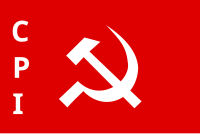Tebhaga movement
| Tebhaga movement | |||
|---|---|---|---|
| Part of Cold War and Peasant Revolution against British | |||
 | |||
| |||
| Belligerents | |||
|
|
| ||
| Commanders and leaders | |||
|
|
| ||
| Units involved | |||
|
Police Service | Bengal group | ||
Tebhaga movement (1946–1947) was significant peasant agitation, initiated in Bengal by the All India Kisan Sabha of peasant front of the Communist Party of India.
History
At that time sharecroppers had contracted to give half of their harvest to the landlords. The demand of the Tebhaga (sharing by thirds) movement was to reduce the landlord share to one third.
The movement in 24 Parganas
During the
In Both Bengals
Hindus and Muslims alike participated in this peasant movement, avoiding the riots and communal hatred of forty-six years. The principle of Indian Communist Party was peasant unity on the basis of which the Tebhaga movement spread from district to district leaving aside all fratricidal feuds. Peasant struggles in East and West Bengal were united through the formation of associations, the formation of women workers, struggle funds and political education classes. Farmers from the remote areas of Sundarbans to various parts of North Bengal raised their demand for Tevaga. The main leaders of this movement include Kansari Halder, Ganesh Das, Ajit Bose, Bishnu Chattopadhyay, Ila Mitra, Haji Mohammad Danesh, Debaprasad Ghosh (Patal Ghosh), Sushil Sen, Noor Jalal, Krishnavinod Roy, Bimal Dasgupta, Bhupal Panda, Rupanarayan Roy, Dr. Ganendranath Sarkar, Kali Sarkar. Wide participation of women was one of the characteristics of Tevaga.[4] The first martyrs of Tevaga movement were Samir Uddin and Shivram Majhi of Talpukur village of Chirirbandar upazila of Dinajpur district. Samir Uddin was a Muslim and Shivram Majhi belonged to the tribal Hasda community.
Impact
Hare Krishna Konar played a leading role in getting surplus land held by big land owners in excess of land ceiling laws and kept ‘benami’ (or false names) vested with the state. The quantum of land thus vested was around one million acres (4,000 km²) of good agricultural land. Subsequently, under the leadership of Benoy Choudhury, this land was distributed amongst 2.4 million landless and poor farmers.[5]
References
- ISBN 978-9350021590.
- ^ "District Human Development Report: South 24 Parganas". Chapter 1.2, South 24 Parganas in Historical Perspective, pages 7-9. Development & Planning Department, Government of West Bengal, 2009. Archived from the original on 5 October 2016. Retrieved 3 November 2019.
- ^ "District Human Development Report: South 24 Parganas". (1) Chapter 1.2, South 24 Parganas in Historical Perspective, pages 7-9 (2) Chapter 3.4, Land reforms, pages 32-33. Development & Planning Department, Government of West Bengal, 2009. Archived from the original on 5 October 2016. Retrieved 3 November 2019.
- ^ Bhattacharya, Jayant (1996). Tevaga of Bengal, struggle of Tevaga (in Bengali). Calcutta: National Book agency. pp. 39, 72, 98.
- ^ "The story of a pretender". The Statesman, 9 February 2010. Archived from the original on 7 August 2011. Retrieved 12 November 2010.
- Kunal Chattopadhyay, Tebhaga Andolaner itihas, Progressive Publishers, Kolkata, 1986
- Susnata Das, "Abibhakta Banglar Krishak Sangram :Tebhaga Andolan(1946–47),Kolkata,2002(in Bengali)
- Adrienne Cooper, Sharecropping
- List of peasant revolts
- Tebhaga Sketches and Wood Engravings by Somnath Hore
- Chapter on Tebhaga movement in Jyoti Basu's memoirs
